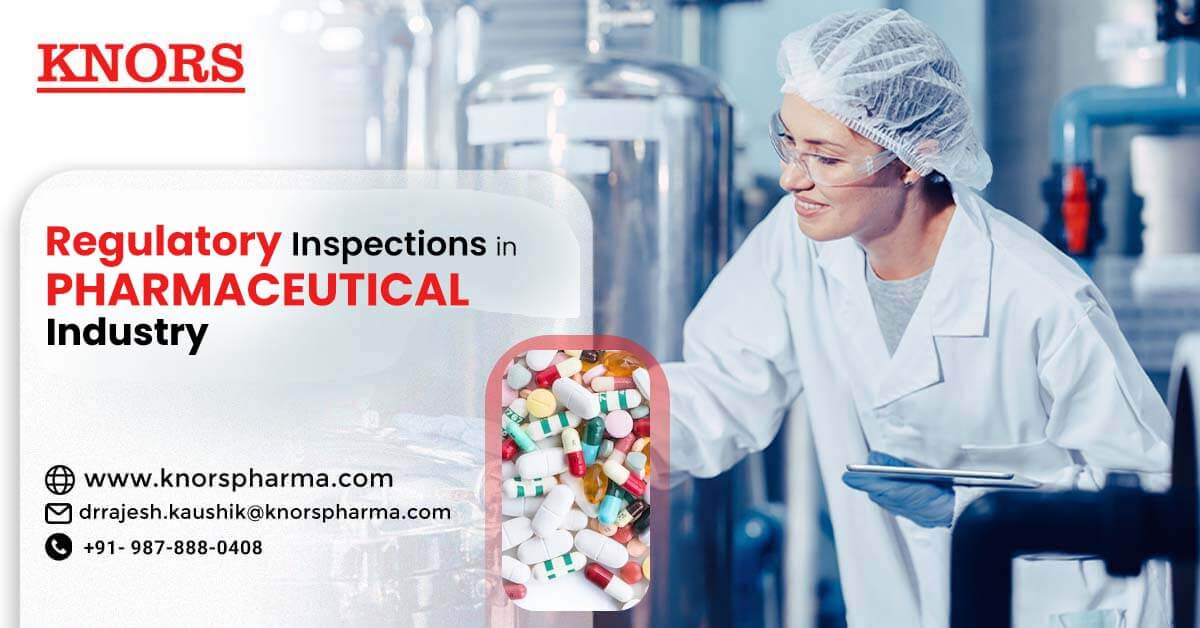Regulatory inspections in the pharmaceutical industry have the huge purpose of regulatory inspection that always ensures the safety, efficacy, and quality of medications. This is useful to ensure compliance with GMP, GLP, & GDP. Along with this, regulatory checks are important to safeguard public health & sustain regulatory trust worldwide.
In the pharma industry, there are various types of regulatory checks you can get, like pre-approval inspection (PAI) to be conducted before product approval and also for focus on manufacturing processes, data integrity, and facility readiness. Along with this, routine GMP inspections allow you to regularly schedule to guarantee continuous compliance. This is also covered with manufacturing, quality assurance, documentation, and employee training.
In addition, different key regulatory bodies conduct inspections, the Central Drugs Standard Control Organization (CDSCO) and the State Food and Drug Administration. In these checks, there is also the huge role of the United States Food and Drug Administration (USFDA) and the European Medicines Agency (EMA). Most importantly, regulatory inspections in the pharma industry are very important because, through them, you can identify the main areas that are examined during inspections.
This includes facility & equipment design, maintenance, and validation. Moreover, in the manufacturing process, SOP compliance, process validation, and batch uniformity are included. Along with this, quality control (QC) includes raw material testing, in-process checks, and final product testing, which is part of these inspections.
The regulatory assessments are an important safeguard ensuring that medicines manufactured and supplied are safe, effective, & consistently high in quality.
Requirements for Regulatory Inspections in the Pharmaceutical Industry
Here, we outline the standards for regulatory inspection in the pharmaceutical business:
Regulatory Compliance Framework: This complied with the GMP (Good Manufacturing Practices), GLP (Good Laboratory Practices), and GDP (Good Distribution Practices). Also, well-established manufacturing companies of pharmaceuticals follow local and international guidelines (CDSCO, USFDA, EMA, WHO, etc.). This is also included with the valid licenses, approvals, and registrations for facilities and products.
Documentation and Records: In this master document are included:
Site Master File (SMF)
Quality Manual
Standard Operating Procedures (SOP)
Batch Record: Batch manufacturing records (BMRS) and Batch Packaging Record (BPR)
Quality Control Data:
Certificate of Analysis (COA)
Analytical Method Validation
Stability Data
Other Records:
Training Records
Equipment Logs and Calibration Records
Change management, deviations, and CAPA (Corrective and Preventive Action) reports.
Facility and Equipment Requirements: This includes:
A well-designed layout with consistent ventilation, humidity, temperature, and also cleanliness
Validated equipment and processes installation, operation, and also performance qualification
Preventive maintenance and calibration programmes
Separate spaces for APIs, excipients, sterile items, and hazardous compounds
Quality Systems: In this system, particularly pharma companies do some effective quality assurance (QA) and quality control (QC) systems. Along with this, they implement change control, deviation handling, & also risk management procedures. Moreover, in regulatory inspections in pharmaceutical industry, they ensure procedures for controlling the manufacturing process & releasing the finished product.
Personnel and Training: An adequate quantity of qualified personnel with specified duties. It also includes documented GMP training (including initial and ongoing refreshers) and health, hygiene, and safety considerations (protective gear, medical examinations).
Consequently, to ensure a smooth regulatory inspection, pharmaceutical companies must have solid documentation, validated facilities/equipment, strong quality systems, trained personnel, and GMP compliance, with evidence available at all times.
Checklist for Regulatory Inspections in the Pharma Industry
Here, we have given a thorough checklist for regulatory inspections in the pharmaceutical industry, encompassing crucial areas that especially regulators like the FDA, MHRA, EMA, DCGI (India), and others frequently assess.
1. Quality Management System (QMS): There is a quality manual, standard operating procedures, and records. This is also included with:
Document Control System
Change Control Procedure is in place
Deviation and Corrective & Preventive Action (CAPA) Systems
Internal Audit and Self Inspection Reports
Training Records for all staff
2. Good Manufacturing Practices (GMP): The premises and facility design fulfill GMP standards (cleanliness, controlled environment, and HVAC validation).
Equipment qualification (IQ/OQ/PQ) and maintenance history
Calibration records for instruments
Validation and qualification of manufacturing processes, cleaning, and also utilities (water, HVAC, compressed air)
Personal hygiene, grooming procedures, and also training
3. Production and Process Control: This process comes with:
Batch manufacturing records (BMR) and batch packing records.
Procedures for conducting in-process inspections and controls
Line clearance processes
Equipment cleaning logs
Material reconciliation specifically includes API, excipients, and packaging materials
Controlled management of rejected materials
4. Quality Control (QC) and Laboratory Control:
Testing records for raw materials, in-process, and final products
Stability tests and retention samples
Records of calibration and qualification for laboratory instruments
Analytical method validation reports
Data integrity compliance comes with the Alcoa+ principles: attributable, legible, contemporaneous, original, and also accurate.
Out-of-spec (OOS) and out-of-trend (OOT) investigations
5. Documentation and Record Keeping:
Master documents (standard operating procedures, master formula records, and specifications)
Logbooks for equipment, utilities, and employees
Data security and electronic record compliance (21 CFR Part 11, if applicable)
Also, an appropriate archival system for documents and records
Types of Inspection in Pharmaceutical Industry
According to industry experts, inspections in pharmaceutical industry are especially conducted by regulatory bodies, internal auditors, and third-party agencies to guarantee compliance with GMP, GLP, GDP, and other regulations. These inspections differ depending on the objective, scope, and also regulatory requirements. Thus, here we have given the following primary types of inspection in pharmaceutical industry:
Pre-approval Inspection (PAI): In this process, pharma companies conduct tests before the approval of a new medicine or facility. They verified manufacturing procedures, facility compliance, and also data integrity as specified in regulatory filings (e.g., NDA, ANDA, & DMF).
Good Manufacturing Practices (GMP) Inspection: Leading pharma businesses make sure to comply with the GMP requirements. This is also included with the strict inspections of facilities, equipment, production processes, quality systems, paperwork, and staff practices.
Routine/Periodic Inspection: In this process, inspections are conducted at regular intervals. This includes an aim to maintain continued conformity with regulatory standards. Also, it covers production, quality control, warehousing, and distribution.
For-cause or Triggered Inspection: This inspection is conducted for specific reasons, such as:
Product recalls
Complaints or adverse events
Suspected data integrity issues
Regulatory noncompliance reports
More targeted and detailed than ordinary inspections
The FDA Inspection Process
Here is a step-by-step explanation of the entire FDA inspection procedure used in the regulatory inspections in the pharmaceutical industry. This is especially helpful for pharmaceutical businesses, QA/RA teams, and anyone preparing for USFDA audits. Thus, for FDA inspection, the complete process is included:
Pre-inspection Phase
The FDA determines the type of inspection, including pre-approval, GMP for cause, and also routine inspections. After this, they review the company’s regulatory filings (NDA, ANDA, DMF, annual reports, and previous audit reports). Moreover, they verify risk assessment for facility, product, or data integrity problems and notification (occasionally). Also, companies may be given advance notice for overseas inspections.
Arrival and Opening Meeting
Form 482 (notice of inspection) is issued by FDA investigators. Moreover, they introduce the FDA inspection team to corporate management. Additionally, explaining the scope, objectives, and projected duration of the inspection is also part of this. Moreover, identification of the company’s inspection handling team (QA, RA, production, and quality control representatives) and close discussion every day are also part of their services.
Exit meeting (Closing Discussion)
If there are any violations discovered during the inspection, the FDA will issue Form 483. However, inspectors also review each observation with management. Even company representatives provide preliminary responses or reasoning.
Post-inspection Phase
If there are any violations discovered during the inspection, the FDA will issue Form 483. However, inspectors also review each observation with management. Even company representatives provide preliminary responses or reasoning.
Post-inspection Phase
This is the time for the establishment inspection report (EIR), the FDA creates a full report of results. Additionally, the company’s response is included with the firms, which must respond to Form 483 observations in writing within 15 business days with CAPA (Corrective and Preventive Actions). These responses must be thorough, including timelines and supporting documentation.
FDA Classification of Inspections
It is finally based on the inspection results; the FDA defines the facility as:
NAI (no action indicated): Fully compliant with no notable problems.
VAI (voluntary action indicated): Objections are recorded, but the firm can correct willingly.
OAI (official action indicated): Serious infractions may result in a warning letter, import alert, seizure, or injunction.
Finalization
In essence, we have deeply discussed the regulatory inspections in pharmaceutical industry, their types, checklists, and requirements. Thus, now we conclude with a few words that Knors Pharma is the leading regulatory inspection service provider in India for the various pharmaceutical, biotech, life sciences, and healthcare companies.



